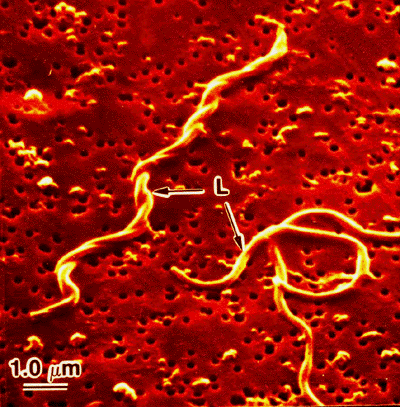Wednesday, May 17, 2006
Parasite of my parasite is not my friend
When teaching biology, one has to cut up the syllabus into edible and digestible chunks, and it makes sense to cover various subdisciplines in separate lectures. As you know, I strive to find ways to make connections to students so they don't leave with a sense that all those subdisciplines are disconnected from each other, almost like separate sciences.
One obvious way to do it is to place everything heavily into an evolutionary context. Another way - and the two go hand-in-hand - is to find really cool diseases, like malaria, in which findings from different areas of biology add up to build a bigger picture of understanding the disease.
Another such disease is Lyme Disease. One is already going to teach, separately, about bacteria, about insects, about mammals, reptiles and birds, about r and K strategies, about trophic levels, about parasitism, about behavior, about oscillations in population sizes, about the immune system, about the effects of human activity on ecosystems, etc. Lyme Disease is a great way to show how all those seemingly disparate topics fit all together.
 Lyme Disease is caused by a bacterium, Borrelia burgdorferi. It is transmitted by deer ticks (Ixodes scapularis). Many mammals, including deer, horses and cattle, as well as some birds and lizards, can carry the bacterium and be the source of it for the ticks. However, the most important source are rodents, particularly the white-footed mice (see picture - Peromyscus leucopus).
Lyme Disease is caused by a bacterium, Borrelia burgdorferi. It is transmitted by deer ticks (Ixodes scapularis). Many mammals, including deer, horses and cattle, as well as some birds and lizards, can carry the bacterium and be the source of it for the ticks. However, the most important source are rodents, particularly the white-footed mice (see picture - Peromyscus leucopus). Back in 1997, Richard Ostfeld published an article in American Scientist about Lyme Disease: The ecology of Lyme-disease risk (Am Sci 85: 338–346. - not available online). I used that article as supplemental reading for my students a couple of times few years ago, as it does a great job of putting everything together. It also has an additional message that ecology is not just about saving the whales and spotted owls, but essential for our own health, in cases such as Lyme Disease (as well as Malaria, West Nile virus, etc.) and it often happens that field ecologists and not molecular biologists provide the key pieces of information about the disease that can be immediatelly used to predict, protect from, or cure the illness.
Back in 1997, Richard Ostfeld published an article in American Scientist about Lyme Disease: The ecology of Lyme-disease risk (Am Sci 85: 338–346. - not available online). I used that article as supplemental reading for my students a couple of times few years ago, as it does a great job of putting everything together. It also has an additional message that ecology is not just about saving the whales and spotted owls, but essential for our own health, in cases such as Lyme Disease (as well as Malaria, West Nile virus, etc.) and it often happens that field ecologists and not molecular biologists provide the key pieces of information about the disease that can be immediatelly used to predict, protect from, or cure the illness. One of the notions put forward in the article was that abundance of acorns in one year leads to abundance of rodents (mostly white-footed mice and chipmunks) the next year, and abundance of ticks - thus Lyme Disease - the third year. Now, Ostfeld and collaborators have added several more years of data and performed a detailed analysis of a large (13 years) dataset that strongly suggests that their initial hunch was correct. The paper has just been published online (free for all to see!) on PLoS-Biology:
One of the notions put forward in the article was that abundance of acorns in one year leads to abundance of rodents (mostly white-footed mice and chipmunks) the next year, and abundance of ticks - thus Lyme Disease - the third year. Now, Ostfeld and collaborators have added several more years of data and performed a detailed analysis of a large (13 years) dataset that strongly suggests that their initial hunch was correct. The paper has just been published online (free for all to see!) on PLoS-Biology:Climate, Deer, Rodents, and Acorns as Determinants of Variation in Lyme-Disease Risk (PDF)
This, for all practical purposes, eliminates alternative hypotheses that were popular in the field, e.g., that growing-season temprature or the abundance of white-tailed deer are the best predictors of outbreaks of Lyme Disease. They write:
"Risk of human exposure to vector-borne zoonotic pathogens is a function of the abundance and infection prevalence of vectors. We assessed the determinants of Lyme-disease risk (density and Borrelia burgdorferi-infection prevalence of nymphal Ixodes scapularis ticks) over 13 y on several field plots within eastern deciduous forests in the epicenter of US Lyme disease (Dutchess County, New York). We used a model comparison approach to simultaneously test the importance of ambient growing-season temperature, precipitation, two indices of deer (Odocoileus virginianus) abundance, and densities of white-footed mice (Peromyscus leucopus), eastern chipmunks (Tamias striatus), and acorns (Quercus spp.), in both simple and multiple regression models, in predicting entomological risk. Indices of deer abundance had no predictive power, and precipitation in the current year and temperature in the prior year had only weak effects on entomological risk. The strongest predictors of a current year's risk were the prior year's abundance of mice and chipmunks and abundance of acorns 2 y previously. In no case did inclusion of deer or climate variables improve the predictive power of models based on rodents, acorns, or both. We conclude that interannual variation in entomological risk of exposure to Lyme disease is correlated positively with prior abundance of key hosts for the immature stages of the tick vector and with critical food resources for those hosts."You can read the whole article - it is not very difficult - as well as a nice introductory editorial about it: A New View on Lyme Disease: Rodents Hold the Key to Annual Risk:
----snip-----There is an excellent website at John Hopkins University explaining the ins and outs of Lyme Disease for more information. Aetiology also mentions the study and Zygote Games has an excellent commentary.
Lyme disease, like other zoonoses, is transmitted by a vector that picks up the pathogen during a blood meal from a vertebrate host. In the eastern and central United States, the spirochete bacterium Borrelia burgdorferi infects blacklegged ticks, Ixodes scapularis, which feed on a wide variety of birds, lizards, and mammals, including mice, deer, and humans. Since human risk is a function of the prevalence of infection among vectors, outbreak prevention depends in part on understanding what controls infection rates among the agents of transmission.
In a new study, Richard Ostfeld, Felicia Keesing, and colleagues examined the ecological determinants of Lyme disease over a 13-year period in southeastern New York, a hot zone for the disease. Combining field data with computer simulations, they analyzed trends in interannual variation and found two powerful predictors of entomological risk of Lyme disease in a given year: abundance of tick hosts—white-footed mice and chipmunks—in the previous year and abundance of acorns—which sustain the rodents—two years out. Their findings upset the long-held view that deer and climate are the best indicators of disease risk.
----snip-----





















